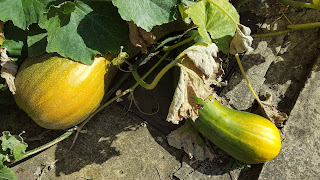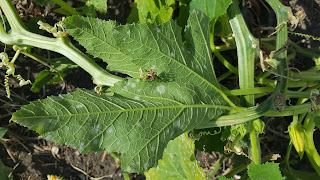The first part of the project involved going to B&Q while the cheapest sort of decking boards were on special offer and buying a surprisingly large quantity of it. We needed more than would fit in the car on a single trip. In the next phase, my husband cut the boards into the lengths we needed for all the places where the full length of the board was too long and to go round the curved area of grass.
Then he stained all of the boards and the wooden pegs black and left them to dry. The logic behind the staining was that it should prolong the life of the wood. The logic behind the choice of black was that we already had some left over from the wood store and it should look good with that.Finally, he screwed the stakes to the backs of the boards. We decided the side with the lines scored in them should be the backs (facing the beds), as we think grass would otherwise be likely to get stuck unattractively in there when we strim.
It looks particularly impressively neat round by the shed, where the narrow pieces of stone that weren't really wide enough have been replaced by large slabs and the beds have been sectioned off from these by boards.
My other half then reseeded the parts of the lawn that had gone bald or changed shape (he neatened up the shapes of a few of my beds and made lines straighter and less prone to random-seeming changes). It's about as late in the year as you can sow grass, so fingers crossed it starts to grow.
In other news from the garden, all of my cosmos is finally in full bloom.
It spills over the lawn and is a bit of a mess and I'm under strict instructions not to plant it again next year, as it refuses to flower for me until late September and gets huge in the meantime, but for now it is lovely.
Also, my biggest squash has unfortunately split and fluffy, white mould has got in, so I no longer have the delightful question of how to deal with cooking and eating a vegetable that huge. The cracks only spread to the top of it a few days ago, but when I turned it over there were even bigger cracks. I think it may have been like that for a while. In case it's related to all the rain we've had recently I took the other squashes inside to store for winter. They're currently providing a festive display on the dining room table. I am still keeping the cracked squash for seeds though. The person who gave me the seeds in the first place said the cracked one was bigger than hers ever grew!
Also, a couple of mushrooms popped up in the grass. I took this as a good sign that we have healthy fungal connections throughout the soil.




















































